Performance Reporting — Continued
| Goal 1: High Quality
Patient Centred Care |
| Objective 1: Health
services are delivered according to best practices and standards. |
| Strategies: |
|
• Work with health authorities and providers to implement
and audit health service standards.
|
Underway |
|
• Introduce strategies to improve the care of people with
chronic health conditions.
|
Underway |
Achievements:
- Performance agreements were established to outline expectations
for health authorities' performance. A framework is being developed
for monitoring levels of care, such as acute care and mental
health services within each health authority.
- BC established patient registries for diabetes and congestive
heart failure so that health professionals can be proactive
in scheduling tests and providing information.
- Targets for rates of compliance with diabetes testing standards
were established. More protocols and standards are under development
for congestive heart failure, asthma and other chronic health
conditions.
- Chronic disease management Web site was established, including
a secure Web site for practitioners to help assess level of
care provided against BC standards.
- Planning for physician collaboratives was completed. These
will facilitate the development and distribution of evidence-based
practice guidelines.
Performance Measures

Rates of
compliance with selected protocols and standards (Goal 1:
PM#1)
This indicator measures the number of patients with chronic illness
who receive services that meet the standards and guidelines set
by health professionals.
The 2002/03 measurement is of the percentage of patients with
diabetes receiving at least 2 blood glucose (HbA1c) tests during
the year, as set in BC's diabetes guidelines. Diabetes is one
of the most common chronic diseases, affecting about five per
cent of Canadians, and its prevalence is expected to increase
significantly due to an aging population and rising rates of obesity.
Blood glucose tests help flag potential complications for persons
with diabetes.
Results
| 2002/03 Target |
2002/03 Actual |
Status |
| Consider conditions and set targets in
collaboration with the British Columbia Medical Association
(BCMA) |
Targets were established to measure the
percentage of patients with diabetes receiving at least 2
blood glucose (HbA1c) tests during the year.
Established
Target 02/03: 45%
Target 03/04: 55%
Target 04/05: 60%
Target 05/06: 65%
|
Met target |
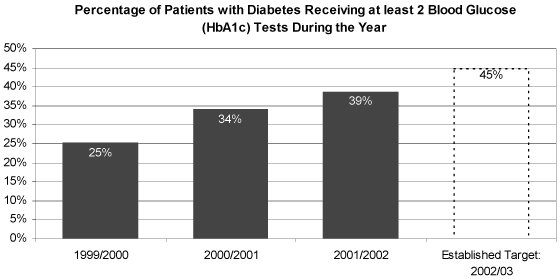
Source: BC Diabetes Registry, Population Health Surveillance
and Epidemiology Branch, MSP Economic Analysis Branch.
Goal 1: PM#2a, 2b, and 2c
- PM#2a: 30-day in-patient mortality or death rates for acute
myocardial infarction (heart attack) and stroke
- PM#2b: 5-year survival rates for lung, prostate, breast
and colorectal cancer; relative survival rates for heart attack
(365 days after admission to hospital) and stroke (180 days
after admission)
- PM#2c: Hospital re-admission rates for heart attack, congestive
heart failure, pneumonia, and gastro-intestinal hemorrhage
Results
| 2002/03 Target |
2002/03 Actual |
Status |
| Set targets |
Performance measures not carried forward |
See explanatory note below |
Data for these three performance indicators cannot be provided
within the required time frame of the Budget Transparency and
Accountability Act and the Balanced Budget and Ministerial
Accountability Act. As these measures are national health
indicators, they will continue to be reported publicly in the
Performance Indicator Reporting Committee and Canadian Institute
of Health Information indictor reports.
Source: AMI and Stroke: BC administrative databases; Discharge
Abstract Database / Hospital Morbidity database (CIHI); POI database,
Vital Statistics files, and life tables (Statistics Canada); ISQ.
| Goal 1: High Quality
Patient-Centred Care |
| Objective 2: Care is
provided at the appropriate level in the appropriate setting. |
| Strategies: |
|
| • Rationalize and redesign hospital care. |
Underway |
| • Reallocate resources and develop policy
to support innovative community, home care and palliative
care services as alternatives to institutional care. |
Underway |
| • Provide 5,000 new home and community care
placements (beds). |
Underway |
| • Implement an integrated health information
system to facilitate better patient care across programs. |
Underway |
Achievements:
- Regional health authorities are at various stages of consolidating
acute care services and creating inter-linked systems of small
community hospitals or treatment centres for basic emergency
services, larger community hospitals and regional referral centres.
- A new Residential Access Policy was introduced to ensure that
admittance to long-term care facilities is based on need.
- The government passed the Community Care and Assisted Living
Act to modernize regulation of care facilities, enable more
local decision making to ensure appropriate care options, and
support development of assisted living units.
- Across the health authorities, 3,500 assisted living units
are being provided under the Independent Living BC program,
and additional units are being made available through other
partnerships.
- Finally, a strategic visionary plan and an annual tactical
plan have been completed for developing a provincial information
system that will improve patient care. A key goal is to connect
health professionals and facilities to allow development of
an electronic health record for each patient. This will enable
better decisions about the health care provided and ensure appropriate
care at all levels.

Performance Measures

Rates of admission for conditions that could be managed outside
hospital (classified as may not require hospitalization)
(Goal 1: PM#2d)
May Not Require Hospitalization (MNRH) shows the rate of hospital
admissions for conditions that could be managed outside hospital.
This measure can help identify opportunities to reduce some categories
of inpatient admissions and redirect care to others requiring
hospital services.
2002/03 data from the Canadian Institute of Health Information
(CIHI) is not available at this time due to delays in the cross-Canada
implementation of a new classification scheme (ICD10-CA).
Results
| 2002/03 Target |
2002/03 Actual |
Status |
5% decrease
Baseline: 2000/01 |
Data for 2001/02 and 2002/03 not yet available |
Pending* |
Source: Discharge Abstract Database, Information Support,
Regional Programs, BC Ministry of Health; Population tables from
PEOPLE26, BC Stats.
Percentage of home and community care clients with high care
needs living in their own home (intermediate care level 3 or above)
(Goal 1: PM#3a)
This indicator tracks the number of seniors and people with disabilities
who have high care needs and receive home support or adult day
care, allowing them to remain more independent and autonomous
in their own home. Clients with high care needs are those who
require intermediate or extended care — intermediate care
level 3 or higher.
Results
| 2002/03 Target |
2002/03 Actual |
Status |
2% increase in the number of high care
needs clients
Baseline: 2001/02 |
12.5% increase |
Exceeded target |
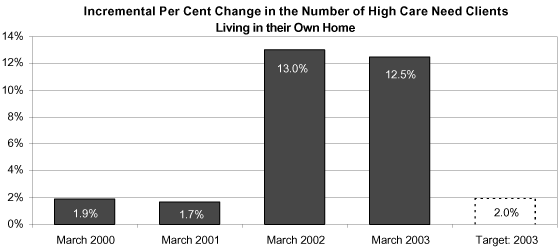
| |
March 1999 |
March 2000 |
March 2001 |
March 2002 |
March 2003 |
| Number of High Care Need
Clients Living in their Own Home |
6,292 |
6,414 |
6,523 |
7,370 |
8,292 |
Source: Continuing Care Information Management Systems,
Continuing Care Data Warehouse.
Alternate Level of Care (ALC) days as a percentage of total
inpatient days (Goal 1: PM#3b)
This measure indicates if patients have timely access to appropriate
care in the most appropriate setting. The days that patients spend
in hospital after their need for acute care has ended are called
Alternate Level of Care (ALC) days. Patients remain in hospital
longer than necessary for various reasons, including no available
room in residential facilities or a delay in discharge arrangements.
A reduction in ALC days results in more acute care beds being
available for those who need acute care.
Results
| 2002/03 Target |
2002/03 Preliminary* |
Status* |
5% decrease
Baseline: 2001/02 |
6.1% decrease |
Exceeded target |
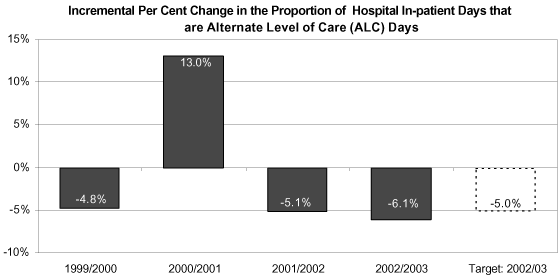
| |
1999/2000 |
2000/2001 |
2001/2002 |
2002/2003* |
Target: 2002/2003 |
| ALC Days |
379,930 |
424,922 |
387,511 |
362,117 |
|
| Inpatient Days |
2,750,961 |
2,730,992 |
2,613,268 |
2,608,313 |
|
| Per Cent |
13.8% |
15.6% |
14.8% |
13.9% |
13.2% |
Source: Discharge Abstract Database, Information Support,
Ministry of Health Services.
Appropriate use of blood products for clinical purposes measured
by utilization of Intravenous/Immune Globulin (IVIG) Blood Products
(Goal 1: PM#5)
This indicator measures the use of intravenous immune globulin
(IVIG), a blood product made from human plasma. This blood product
is licensed for treating some clinical conditions. However, it
is also being used for treating conditions not supported by medical
research. The average cost of IVIG therapy is approximately $70
per gram and the cost per course of treatment regularly exceeds
$10,000. Through the Provincial Blood Coordinating Office, the
ministry has implemented an IVIG Utilization Management Project
to monitor the use of IVIG with the goal of stabilizing and reducing
use of this treatment option.
Results
| 2002/03 Target |
2002/03 Actual |
Status |
Stable (at 66.9 grams per capita)
Baseline: 2001/02 |
Stable |
Met target |
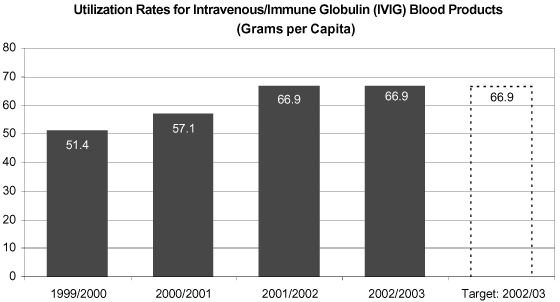
Source: Canadian Blood Services

Administrative and support services expenditures as a percentage
of total expenditures, by health authority (Goal 1: PM#8)
This indicator measures the amount that health authorities spend
on administrative and support services, compared to their total
expenditures. Administrative services include finance services,
human resources and communications. Support services include maintenance,
housekeeping, food services and security. This indicator helps
health authorities plan their spending and ensure every available
dollar is directed towards delivering patient care.
Results
| 2002/03 Target |
2002/03 Preliminary* |
Status* |
Maintain 2000/01 percentage (24.9%)
Baseline: 2000/01 |
Percentage decreased to 21.7% |
Exceeded target |
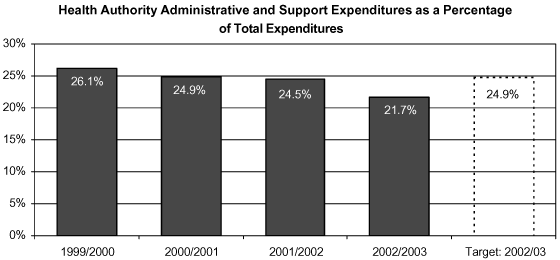
Source: Health Authority Management Information System,
Information Support Branch.
| Goal 1: High Quality
Patient-Centred Care |
| Objective 3: Patients
have equitable and timely access to health care services. |
| Strategies: |
|
|
• Introduce strategies to improve access to basic health
services (primary care).
|
Underway |
|
• Modernize mental health care through the implementation
of the Mental Health Plan.
|
Underway |
|
• Commence implementation of a population needs-based funding
formula to allocate resources to health authorities.
|
Completed |
|
• Establish the Provincial Health Services Authority to reduce
variability in access to specialized services across patient
groups and place of residence.
|
Completed |
|
• Work with the Ministry of Health Planning to implement
the rural and remote health initiative.
|
Underway |
|
• Expand the number of hospitals utilizing the PharmaNet
system and BC BedLine.
|
Completed |
Achievements:
- The Primary Health Care Renewal Project, designed to provide
better access to services, has finished the initial planning
phase. Health authority plans will be implemented in 2003/04.
These include investment in professional and organizational
development, a range of practice models including multi-disciplinary
practice teams, physician collaboratives and other shared care
approaches.
- A comprehensive mental health strategy was launched to: focus
on early detection and evidence-based care; develop a permanent
communications infrastructure to improve mental health literacy;
better integrate mental health care throughout the health system;
and focus on self-management and best practices.
- The Provincial Health Services Authority (PHSA) was established
to ensure specialized services are delivered effectively throughout
BC. It is currently developing a Provincial Perinatal Service,
which will optimize care of high risk pregnant women and their
infants across the province. PHSA is also working with health
authorities to examine patients' needs, provincial capacity
and management of wait lists, under the Cardiac Program.
- Programs such as the doctors' rural incentive agreement, rural
specialist locum program, and expansion of medical school placements
in regional universities encourage health professionals to live
and work in rural BC.
- All acute care hospitals in BC are currently using the BC
BedLine call centre to request help in transferring patients.
The BC BedLine Web site is also being used by hospitals that
regularly receive patient transfers. Thirty hospitals are reporting
their bed availability every four hours on the Web site, and
another 11 are sending daily verbal reports.
Performance Measures

Improved continuity of care measured by the proportion of
persons hospitalized for a mental health diagnosis who receive
community or physician follow-up within 30 days of discharge (Goal
1: PM#4a)
This measures the percentage of persons aged 15–64 who
have been hospitalized for a mental health illness and who receive
at least one follow-up treatment at a community-based Mental Health
Centre (MHC) or with a General Practitioner/Psychiatrist, within
30 days of being discharged from hospital. A high rate of
community or physician follow-up indicates well-coordinated and
accessible continuity of care for people with a mental health
diagnosis.
Results
| 2002/03 Target |
2002/03 Preliminary* |
Status* |
3% increase
Baseline: 2000/01 |
3.1% increase |
Met target |
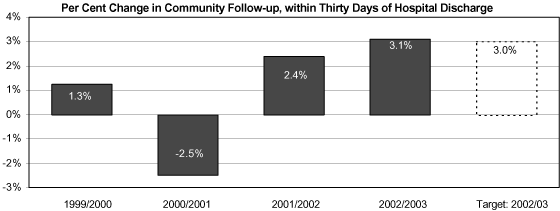
Source: Mental Health Data Warehouse and Discharge Abstracts
Database, Information Support, BC Ministry of Health Services;
MSP Claims.
Improved availability of community services measured by percentage
of days spent by mental health patients in hospitals after
the need for hospital care ended (Goal 1: PM#4bi)
This measures the number of days that Alternate Level of Care
(ALC) mental health patients spend in acute care hospitals, as
a proportion of all in-patient hospital days. Note that this measure
is the same as the previous ALC measure, but focuses on people
who are hospitalized for a mental health diagnosis.
Results
| 2002/03 Target |
2002/03 Preliminary* |
Status* |
No change (maintain or decrease
rate below rate in baseline year)
Baseline: 2001/02 |
Rate decreased |
Exceeded target |
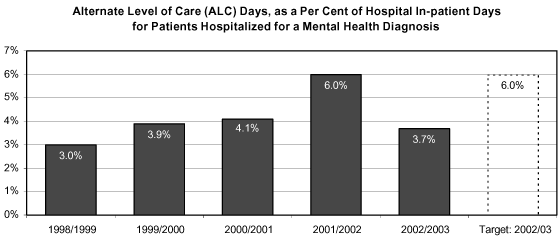
| For patients with a mental health
diagnosis: |
1998/1999 |
1999/2000 |
2000/2001 |
2001/2002 |
2002/2003 |
| ALC Days |
6,720 |
8,858 |
9,467 |
13,896 |
5,040 |
| Inpatient Days |
226,042 |
227,818 |
231,847 |
232,198 |
135,544 |
| ALC Rate Per Cent |
3.0% |
3.9% |
4.1% |
6.0% |
3.7% |
Source: Discharge Abstract Database, Information Support,
Regional Programs, BC Ministry of Health
Percentage of mental health clients receiving services in
their own region (Goal 1: PM#4bii)
This measures the range of services that mental health clients
receive in their own communities or regional health authorities.
It indicates better access and greater availability of mental
health care and community services for clients.
Results
| 2002/03 Target |
2002/03 Preliminary* |
Status* |
Increase (above 85.8%)
Baseline: 2001/02 |
Increased |
Met target |
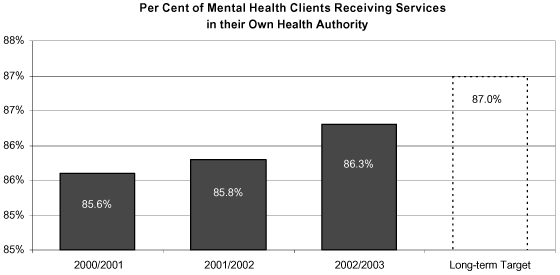
Source: Mental Health Research Data Warehouse, Information
Support, BC Ministry of Health Services.
Proportion of mental health clients accessing community services
(Goal 1: PM#4biii)
This indicator shows the availability of community services by
measuring the percentage of people with a mental disorder who
have received at least one mental health service from a care provider
or health centre in the community.
Over the past five years, an increasing proportion of clients
with mental illnesses are receiving care through community-based
services — at a mental health centre, a physician's office
or both.
Results
| 2002/03 Target |
2002/03 Actual |
Status |
Increase
Baseline: 2000/01 |
Data not yet available |
Pending* |
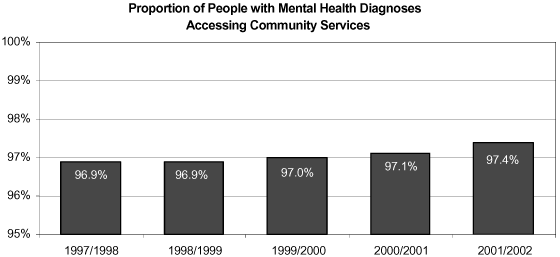
Source: Mental Health Research Data Warehouse, Information
Support, BC Ministry of Health Services.
Waiting times for key services — Radiotherapy and Chemotherapy
(Goal 1: PM#6a)
Monitoring wait times helps ensure patients' cancers are treated
as early as possible to achieve the best outcomes. This indicator
measures the percentage of patients that begin radiotherapy within
four weeks of being ready to treat and the percentage of patients
who start chemotherapy within two weeks of being ready to treat.
The measurement is based on median wait times for these services
and the number of patients treated.
As of March 2003, 87 per cent of patients requiring radiotherapy
started treatment within four weeks of being ready to treat, slightly
below the target of 90 per cent. The 2002/03 target value was
set based on inaccurate baseline data for 2001/02, which estimated
radiotherapy treatment at 88 per cent in that year when it was
actually 82 per cent. Although the 2002/03 treatment rate remains
below the 90 per cent target, results show a significant and steady
improvement over 2000/01, when only 72 per cent of patients began
treatment within four weeks. For chemotherapy, consistently, the
BC Cancer Agency reports that over 90 per cent of patients receive
treatment within two weeks.
The expansion of the Victoria Cancer Clinic provides more radiotherapy
services in BC to meet the increasing demand for these services.
Planning for a new clinic in Abbotsford will help ensure provincial
services keep up with the growing incidence of cancer.
Results
| 2002/03 Target |
2002/03 Actual |
Status |
Radiotherapy:
90% of patients begin treatment within 4 weeks of being ready
to treat |
Radiotherapy:
87% of patients began treatment within 4 weeks of being ready
to treat |
Missed target* |
Chemotherapy:
90% of patients begin treatment within 2 weeks of being ready
to treat |
Chemotherapy:
Over 90% of patients began treatment within 2 weeks of being
ready to treat |
Met target |
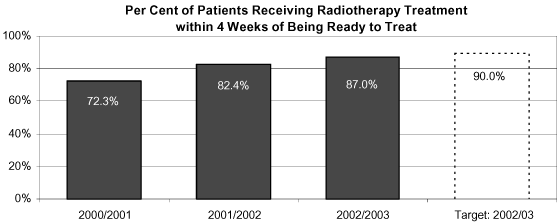
Source: BC Cancer Agency
Regional variation in access to selected services (Goal
1: PM#7)
Measuring regional rates for major surgical procedures helps
compare access to services among health authorities (HA): the
wider the variation, the greater the inequities in accessing services
across health authorities. This indicator specifically measures
utilization rates of hip, knee and cardiac surgeries for regions.
Comparative data for 2002/03 showing variations across BC's regions
will be available in December 2003.
Results
| 2002/03 Target |
2002/03 Actual |
Status |
Reduce variation in regional differences to access services
by 10%
Baseline: 2001/02 |
Data for hip, knee and cardiac surgeries will not be available
for 2002/03 until December 2003 |
Pending* |

| |
Hip Replacement
Surgeries |
Knee Replacement Surgeries |
Coronary Artery Bypass
Surgeries |
| |
2001/02 HA Range |
2002/03 Target Range |
2001/02 HA Range |
2002/03 Target Range |
2001/02 HA Range |
2002/03 Target Range |
| Range in Surgery Rates Across Health Authorities (cases
per 1,000 population) |
30.7 |
27.6 |
52.0 |
46.8 |
19.0 |
17.1 |
Source: Discharge Abstract Database, Information Support,
Ministry of Health Services.
24/7 access to basic health services (primary care) (Goal
1: PM#10)
24/7 access to services is vital to improving primary health
care and building a patient-centred health system in BC. Usage
rates for the BC NurseLine indicate access to skilled care providers
— to specially trained registered nurses — by telephone,
anytime of the day or night, across the province. Further, the
practice among many physicians is to direct their patients to
hospital emergency departments after hours. The NurseLine provides
an alternative for obtaining an objective assessment of patients'
problems.
Results
| 2002/03 Target |
2002/03 Actual |
Status |
| 25% increase in NurseLine use |
43% increase in NurseLine use |
Exceeded target |
15% increase in after hour call-forwarding from physician
offices to NurseLine
Baseline: 2001/02 |
203% increase in after hour call-forwarding from physician
offices to NurseLine |
Exceeded target |
| Number of Calls to the NurseLine |
Number of Times Physicians Call Forwarded
After Hours to the NurseLine |
| 2001/02 99,497 |
2001/02 335 (revised
01/02) |
| 2002/03 142,142 |
2002/03 1,015 |
Source: BC Ministry of Health Services
| Goal 1: High Quality Patient-Centred
Care |
|
| Objective 4: Patient satisfaction and public confidence
in the system are increased. |
|
| Strategies: |
|
• Implement an annual mental health report card.
|
Underway |
|
• Increase access to information to help patients and their
families understand and manage their health through the
self-care project, the NurseLine and other patient self-care
approaches.
|
Completed |
Achievements:
- BC HealthGuide Program: Since April 2001, over 1.8 million
books have been distributed to households, health professionals,
and health related agencies in BC; more than 1,000,000 hits
have been made to BC HealthGuide OnLine; and 27,000 BC First
Nations Health Handbooks were distributed to aboriginal communities
throughout BC.
- BC NurseLine: Since opening, the BC NurseLine has provided
health information and advice to over 240,000 callers.
- Through the Provincial Chronic Disease Strategy, the province
gives the public and service providers Web-based access to information
and tools to manage chronic diseases.
Performance Measures

Public satisfaction rates (Goal 1: PM#9)
This indicator measures peoples' level of satisfaction with health
services in general and with services received in a hospital,
doctor's office or community centre. This information helps identify
improvements from the patient's perspective, and consequently
supports system accountability and a shift towards a patient-centered
health system.
Original targets were selected based on a 2001 Leger Survey1.
This survey indicated that 56.6 per cent of Canadians
were satisfied with the health system, compared with 41.1 per cent
of respondents who were not satisfied. In BC, 46.6 per cent of
respondents were satisfied with the health system. The Leger Survey
has not been repeated.
The recently released 2003 Aventis Healthcare Survey, which surveyed
1,500 people with employer-sponsored health plans, found that
23 per cent of respondents said the health care system was excellent/very
good and a further 58 per cent said it was good. Comparable figures
at the national level were 30 per cent and 52 per cent respectively.
Results
| 2002/03 Target |
2002/03 Actual |
Status |
| Maintain public satisfaction levels at current rate of 45
– 50% satisfied with the way health services are provided |
Comparable 2002 data not available
Similar data show: 23% rate health care system as excellent/good
58% rate health care system as good |
Met target |
Source: The 2003 Aventis Healthcare Survey; Research,
Rogers Healthcare and Financial Services Group.
